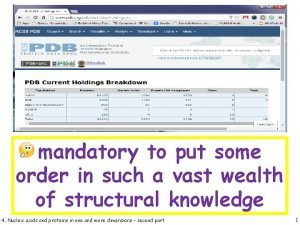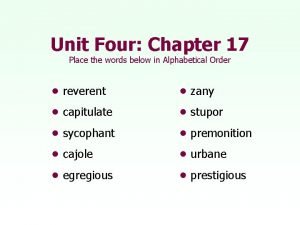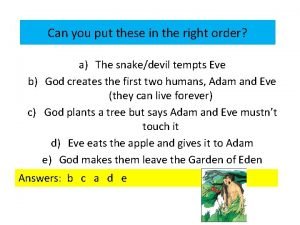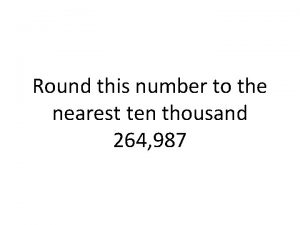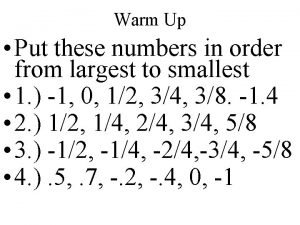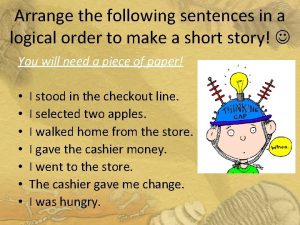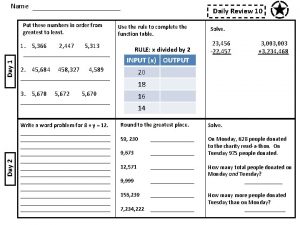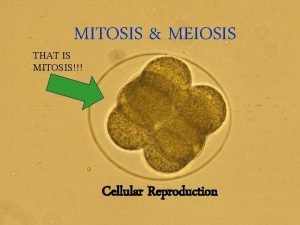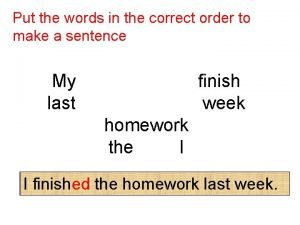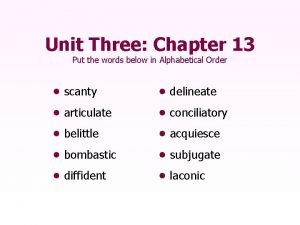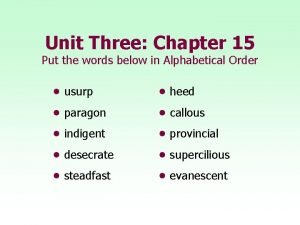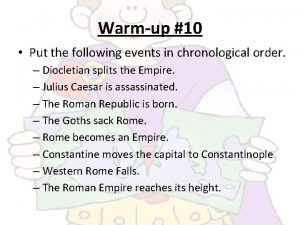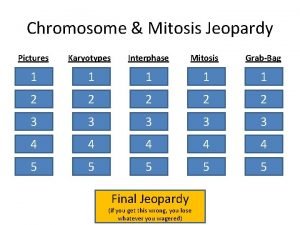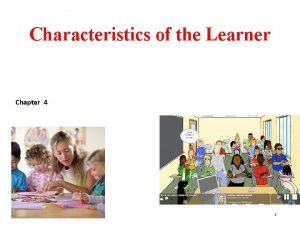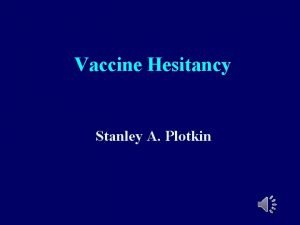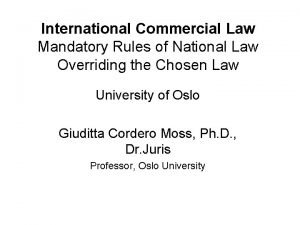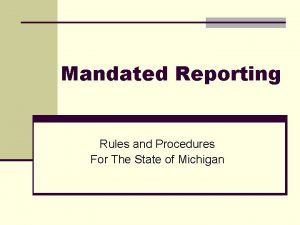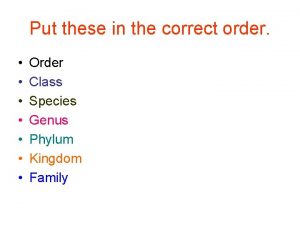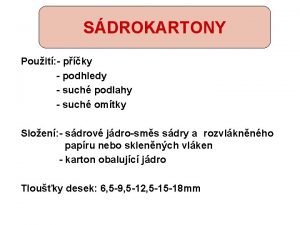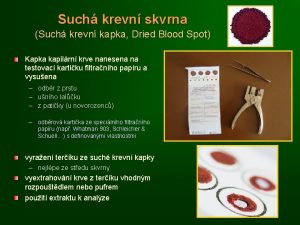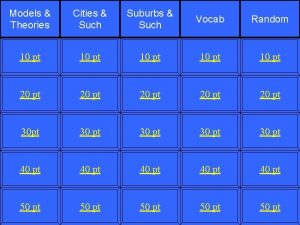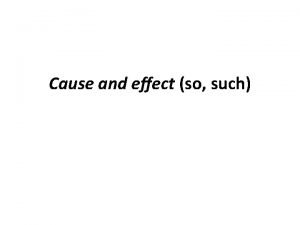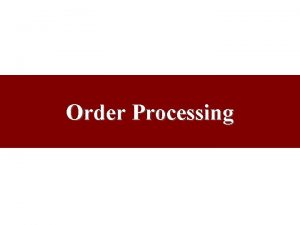mandatory to put some order in such a























































- Slides: 55

mandatory to put some order in such a vast wealth of structural knowledge 4. Nucleic acids and proteins in one and more dimensions - second part 1

Learning from Biology Taxonomy (from Ancient Greek: τάξις taxis, "arrangement, " and -νομία -nomia, "method") is the science of defining groups of biological organisms on the basis of shared characteristics and giving names to those groups. Organisms are grouped together into taxa (singular: taxon) and given a taxonomic rank; groups of a given rank can be aggregated to form a super group of higher rank and thus create a taxonomic hierarchy. 4. Nucleic acids and proteins in one and more dimensions - second part 2

Learning from Biology 4. Nucleic acids and proteins in one and more dimensions - second part 3

protein structure taxonomy 4. Nucleic acids and proteins in one and more dimensions - second part 4

protein structure taxonomy 4. Nucleic acids and proteins in one and more dimensions - second part 5

protein structure taxonomy 4. Nucleic acids and proteins in one and more dimensions - second part 6

protein structure taxonomy 4. Nucleic acids and proteins in one and more dimensions - second part 7

protein structure taxonomy 4. Nucleic acids and proteins in one and more dimensions - second part 8

protein structure taxonomy 4. Nucleic acids and proteins in one and more dimensions - second part 9

protein structure taxonomy 4. Nucleic acids and proteins in one and more dimensions - second part 10

protein structure taxonomy red: mainly α green: mainly β yellow: αβ blue: low content of secondary structures 4. Nucleic acids and proteins in one and more dimensions - second part 11

protein structure taxonomy most of different protein folds have been already found? from http: //www. proteinstructures. com/Structure/protein-fold. html 4. Nucleic acids and proteins in one and more dimensions - second part 12

comparing protein structure 4. Nucleic acids and proteins in one and more dimensions - second part 13

comparing protein structure 4. Nucleic acids and proteins in one and more dimensions - second part 14

comparing protein structure 4. Nucleic acids and proteins in one and more dimensions - second part 15

Structural genomics ry t me to X y Ra c ra f if d NMR DNA cry o-e lect ron tom ogr aph y 0101#01001010#10111010# 01010001#10010#1001#101 10010#100100100101011#0 3. genome analysis Algorithm Residue THR 0. 0 147. 7 172. 9 THR 107. 2 -125. 3 187. 4 CYS 123. 4 63. 6 103. 7 PRO 60. 3 83. 9 -116. 7 Protein Structure 16

from structural knowledge to structural predictions 4. Nucleic acids and proteins in one and more dimensions - second part 17

secondary structure prediction 4. Nucleic acids and proteins in one and more dimensions - 18

secondary structure prediction 4. Nucleic acids and proteins in one and more dimensions - 19

secondary structure prediction CHOU & FASMAN 4. Nucleic acids and proteins in one and more dimensions - Chou, P. Y. & Fasman, G. D. (1974). Biochemistry, 13, 211 -222. 20

secondary structure prediction # residues in window: 6 4. Nucleic acids and proteins in one and more dimensions - 21

secondary structure prediction 4. Nucleic acids and proteins in one and more dimensions - 22

secondary structure prediction 4. Nucleic acids and proteins in one and more dimensions - 23

secondary structure prediction 4. Nucleic acids and proteins in one and more dimensions - 24

secondary structure prediction 4. Nucleic acids and proteins in one and more dimensions - 25

secondary structure prediction PSIPRED is a simple and reliable secondary structure prediction method, incorporating two feedforward neural networks which perform an analysis on output obtained from PSI-BLAST (Position Specific Iterated - BLAST). 4. Nucleic acids and proteins in one and more dimensions - 26

secondary structure prediction 4. Nucleic acids and proteins in one and more dimensions - 27

secondary structure prediction 4. Nucleic acids and proteins in one and more dimensions - 28

4. Nucleic acids and proteins in one and more dimensions - second part 29

Sequence Alignment “Two homologous sequences whisper. . . a full multiple alignment shouts out loud. ” in Hubbard TJ, Lesk AM, Tramontano A. Gathering them in to the fold. Nat Struct Biol. 1996 Apr; 3(4): 313. ) 4. Nucleic acids and proteins in one and more dimensions - second part 30

4. Nucleic acids and proteins in one and more dimensions - second part 31

4. Nucleic acids and proteins in one and more dimensions - second part 32

dotplot The dotplot is a simple picture that gives an overview of the similarities between two sequences. Less obvious is its close relationship to alignments. The dotplot is a table or matrix. The rows correspond to the residues of one sequence and the columns to the residues of the other sequence. In its simplest form, the positions in the dotplot are left blank if the residues are different, and filled if they match. Stretches of similar residues show up as diagonals in the upper left-lower right (Northwest-Southeast) direction. Dotplot showing identities between a repetitive sequence (ABRACADABRA) and itself. The repeats appear on several subsidiary diagonals parallel to the main diagonal. Letters corresponding to isolated matches are shown in non-bold type. The longest matching regions, shown in boldface, are the first and last names DOROTHY and HODGKIN. Shorter matching regions, such as the OTH of dor. OTHy and crowfo. OTHodgkin, or the RO of do. ROthy and c. ROwfoot, are noise. From Introduction to Bioinformatics by Arthur M. Lesk 4. Nucleic acids and proteins in one and more dimensions - second part Dotplot showing identities between the palindromic sequence MAX I STAY AWAY AT SIX AM and itself. The palindrome reveals itself as a stretch of matches perpendicular to the main diagonal. 33

http: //vlab. amrita. edu/? sub=3&brch=274&sim=1434&cnt=1 34

4. Nucleic acids and proteins in one and more dimensions - 35

BLOSUM 62 matrix does an excellent job detecting similarities in distant sequences, and this is the matrix used by default in most recent alignment applications such as BLAST 4. Nucleic acids and proteins in one and more dimensions - second part 36

Mutation probability matrix for the evolutionary distance of 250 PAMs 4. Nucleic acids and proteins in one and more dimensions - second part 37

4. Nucleic acids and proteins in one and more dimensions - 38

4. Nucleic acids and proteins in one and more dimensions - 39

tertiary structure prediction 4. Nucleic acids and proteins in one and more dimensions - 40

tertiary structure prediction 4. Nucleic acids and proteins in one and more dimensions - 41

tertiary structure prediction 4. Nucleic acids and proteins in one and more dimensions - 42

Amino Acid Code teminates with > 4. Nucleic acids and proteins in one and more dimensions - Meaning A Alanine B Aspartic acid or Asparagine C D E F G H I K L M N O P Q R S T U V W Y Cysteine Z Glutamic acid or Glutamine X * any - gap of indeterminate length Aspartic acid Glutamic acid Phenylalanine Glycine Histidine Isoleucine Lysine Leucine Methionine Asparagine Pyrrolysine Proline Glutamine Arginine Serine Threonine Selenocysteine Valine Tryptophan Tyrosine translation stop 43

4. Nucleic acids and proteins in one and more dimensions - 44

45

tertiary structure prediction 4. Nucleic acids and proteins in one and more dimensions - second part 46

tertiary structure prediction 4. Nucleic acids and proteins in one and more dimensions - second part 47

tertiary structure prediction 4. Nucleic acids and proteins in one and more dimensions - second part 48

Protein folding ab initio calculations of protein structure 4. Nucleic acids and proteins in one and more dimensions - second part 49

Metodo Assemblaggio di frammenti: Dividendo la sequenza in frammenti MSSPQAPEDGQGCGDRGDPPGDLRSVLVTTV ROSETTA Frammenti di 9 aa Sceglie le strutture delle 25 sequenze più vicine Ottimizzazione e Assemblaggio (Knowledge-based potential) 4. Nucleic acids and proteins in one and more dimensions - second part 50

Rosetta Fragment Libraries n 25 -200 fragments for each 3 and 9 residue sequence window n Selected from database of known structures > 2. 5Å resolution < 50% sequence identity n Ranked by sequence similarity and similarity of predicted and known secondary structure 4. Nucleic acids and proteins in one and more dimensions - second part 51

4. Nucleic acids and proteins in one and more dimensions - second part 52

RNA structure prediction 4. Nucleic acids and proteins in one and more dimensions - second part 53

RNA structure prediction Primary structure of RNA Secondary structure of a telomerase RNA Tertiary structure of RNA 4. Nucleic acids and proteins in one and more dimensions - second part 54

RNA structure prediction 4. Nucleic acids and proteins in one and more dimensions - second part 55
 Put some order here
Put some order here Via optica
Via optica Othello put out the light
Othello put out the light You put your right hand in
You put your right hand in Some natural resources such as wheat and cattle are
Some natural resources such as wheat and cattle are Photosynthesis is important to animals because flocabulary
Photosynthesis is important to animals because flocabulary The sun is high, put on some sunblock.
The sun is high, put on some sunblock. Cake is countable or uncountable
Cake is countable or uncountable Some may trust in horses
Some may trust in horses Contact and non contact forces
Contact and non contact forces They say it only takes a little faith
They say it only takes a little faith Some say the world will end in fire some say in ice
Some say the world will end in fire some say in ice They say it only takes a little faith to move a mountain
They say it only takes a little faith to move a mountain Some say the world will end in fire some say in ice
Some say the world will end in fire some say in ice Put the pictures in the correct order
Put the pictures in the correct order To put things in order
To put things in order Put the words below in alphabetical order
Put the words below in alphabetical order Put these words in a sentence
Put these words in a sentence Ordering fractions decimals and percentages
Ordering fractions decimals and percentages Put the following events in the correct order.
Put the following events in the correct order. Put these in order
Put these in order Round 264 to the nearest ten
Round 264 to the nearest ten Make word from letters
Make word from letters How do you rearrange sentences in correct order?
How do you rearrange sentences in correct order? Put the letters into the correct order
Put the letters into the correct order Put these numbers in order
Put these numbers in order Arrange sentence in correct order tool
Arrange sentence in correct order tool Put these in order
Put these in order Mitosis and meiosis
Mitosis and meiosis Put the words into correct order
Put the words into correct order Meaning of articulate
Meaning of articulate Put a or an to the words below
Put a or an to the words below Julius caesar chronological order
Julius caesar chronological order Phases of mitosis in order
Phases of mitosis in order Put these in order
Put these in order Mandatory reporting
Mandatory reporting What are the determinants of learning
What are the determinants of learning Virginia mandatory reporting law domestic violence
Virginia mandatory reporting law domestic violence Erd vs erm
Erd vs erm Are camp counselors mandated reporters
Are camp counselors mandated reporters Mandatory product adaptation
Mandatory product adaptation Mandatory vaccination
Mandatory vaccination 250000000/20000
250000000/20000 Army mrd
Army mrd Fp&m seta contact details
Fp&m seta contact details Little league international rules
Little league international rules Lrec purchase agreement
Lrec purchase agreement Mandatory rules examples
Mandatory rules examples Mandatory protection system
Mandatory protection system Mandated reporter training massachusetts
Mandated reporter training massachusetts Voluntary corporate action
Voluntary corporate action Lucien febvre possibilism
Lucien febvre possibilism Mandatory declassification review
Mandatory declassification review Mandatory reporter training assessment answers colorado
Mandatory reporter training assessment answers colorado Mandatory training definition
Mandatory training definition Mandated reporter training michigan
Mandated reporter training michigan
